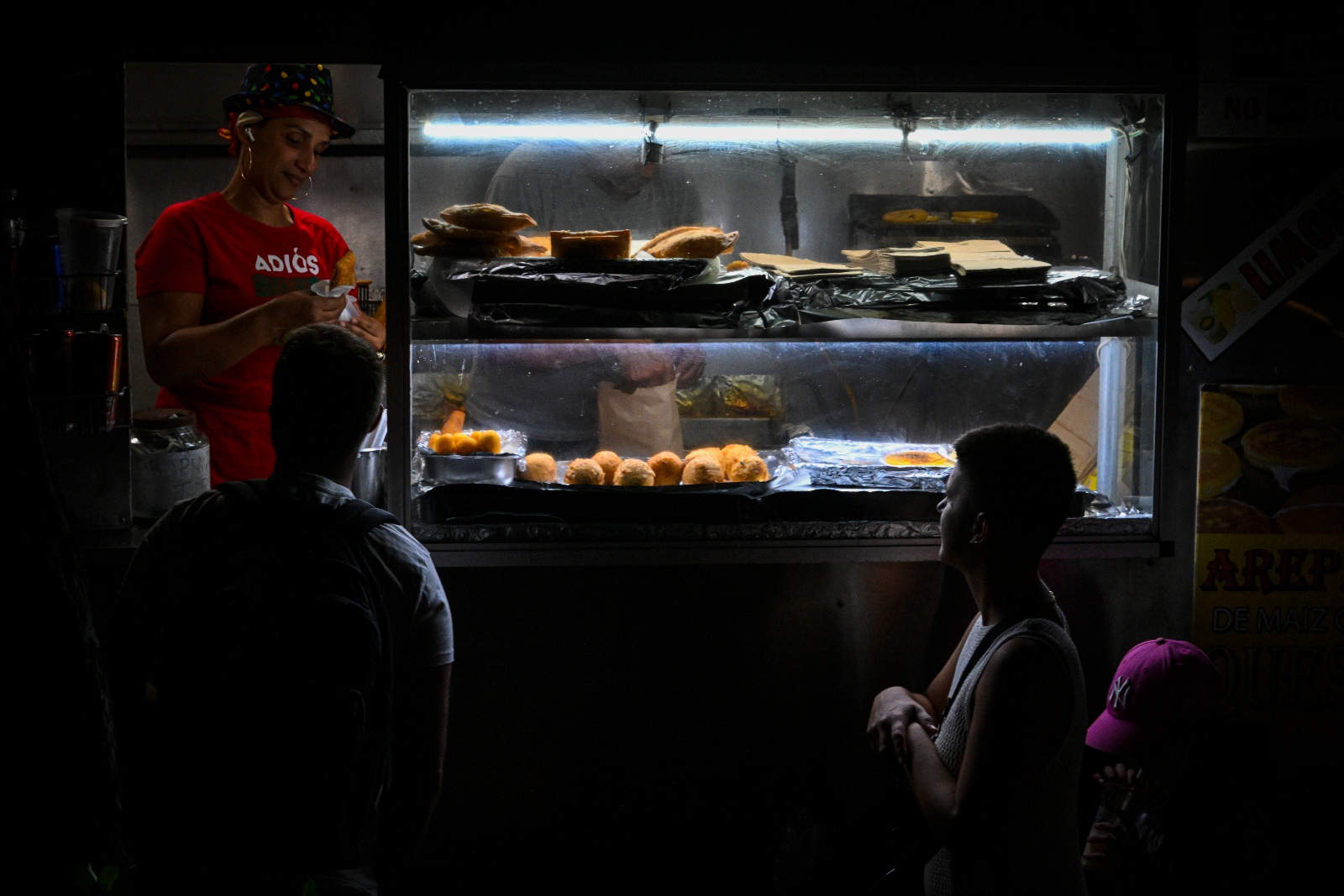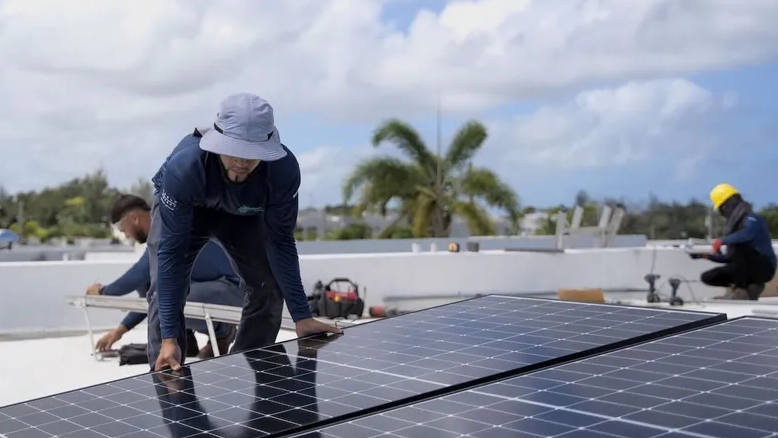Around 5:30 in the morning on December 31, Yvonne Santiago was woken up by a sudden stillness: The fans had switched off. It must be a power outage, she quickly reasoned, and went back to sleep.
When she woke up again hours later, she learned that the outage wasn’t contained to Bayamón, the Puerto Rican city where she was spending the holidays with her boyfriend’s family, but was in fact an island-wide blackout. “Reading the news, I burst out laughing,” she said.
“We have a saying: Ríe para no llorar — laugh to not cry,” she explained. “Things are constantly happening on this island. We’re always on alert, but we also have to let go of certainty.”
Then she set about the practical tasks that a potentially prolonged blackout demands. “The first thing that always freaks me out are the fridges, the food,” she said. She and her boyfriend packed the contents of their fridge into the ground floor of his parents’ house, which has solar power that stayed on during the blackout. Other power outages across the island have marked the first weeks of the year.
Santiago, an illustrator and an archivist at the General Archives of Puerto Rico, said her decisions were characterized by a listlessness she’s come to find familiar in the seven years since Hurricane Maria — a period in which blackouts have become a feature of daily life in Puerto Rico. “Every time the light goes out for such a long period of time, everyone’s kind of out of it,” Santiago said. “It becomes this weird twilight zone where no one knows what to do — I guess we go into survival mode. It becomes this weird limbo.”
Hurricane Maria was the deadliest natural disaster in the U.S. since 1900 — and it was the moment “when we all truly realized we are an island in the Caribbean,” Santiago said, “because it took so long for people to come help us.” Besides killing thousands of people, the storm also laid waste to the island’s already decaying electric grid.
By evening on New Year’s Eve, the lights still weren’t on. Santiago was supposed to attend a party but decided not to go. “We cancelled any plans that we had, because we didn’t know what areas were gonna have electricity or not and it can be pretty dangerous if the street lights aren’t on, so we stayed at home with candlelight,” she said. Without knowing how long the blackout would last, the family was reluctant to use the limited amount of power from the solar panels to microwave the food in the fridge. She ate a bag of Tostitos for dinner.
The essential public infrastructure destroyed by Hurricane Maria was not adequately rebuilt; it was privatized. In 2020, Puerto Rico’s energy transmission and distribution system was sold to an American-Canadian consortium called Luma Energy, which is overseen by Puerto Rican government agencies. And in 2023, the power generation system was similarly privatized, with all power plants under the control of a subsidiary of the American natural gas company New Fortress Energy.
The writer Naomi Klein has analyzed these moves as a textbook application of the “shock doctrine” — a paradigm whereby capital interests take advantage of disasters to undermine public institutions and turn giant profits. In Puerto Rico, the energy privatization set off a massive protest movement whose slogan was Fuera Luma! (“Get out Luma!”).
Since Luma took over the electricity grid, it has raised electricity prices repeatedly — without delivering results for Puerto Ricans like Santiago, who was driven out of her last apartment in San Juan by a problem she’s found even more disruptive than the frequent blackouts: unpredictable power surges. At night, particularly if her neighbors’ lights were on, the electricity flickered on and off at random. The fluctuations destroyed three of her refrigerators in succession. After Luma didn’t respond to her repeated complaints, she finally stopped paying the rising utility bills.
When a power surge destroyed her air conditioner, she decided she had to finally move out of her apartment — but she currently owes Luma nearly $3,000 in unpaid bills. In order to turn the lights on at her new apartment, she will have to sign up for a payment plan.
The energy crisis has affected Santiago’s work, too — and the security of the archives it is her job to preserve. “I deal with digitization and digital preservation, which is really hard to do when you’re having constant outages,” she said. In 2023, a storm flooded a transformer, and the General Archives lost power for months. More recently, one of her hard drives was destroyed, possibly by a power surge.
In those archives, Santiago recently found a document that reminded her of just how old the problems Puerto Rico is facing really are. It was a 1934 “manifesto to the country” published in El Mundo, a San Juan newspaper, written by Luis Muñoz Marín, then a senator in the Puerto Rican legislature — and later the island’s first elected governor.
The manifesto contained a warning to Puerto Ricans based on inside knowledge Marín had acquired in Washington: Foreign investors were planning, “under more or less alluring disguises,” to exploit the economic and public health crisis the island was suffering in the wake of the Depression and a 1928 hurricane. He said hotel developers, sugar refineries, and bamboo cane growers were using recovery money to “extend and to intrench more firmly the control of absentee capital over the lives of the Puerto Ricans.”
And he warned that the real agenda behind this was to “use recovery funds, and give them to private companies to take over certain things,” Santiago said. “They were going to poison us in our medicine — which did happen — and the Americans were going to use different tactics to have control from far away.”
The parallels to the aftermath of Hurricane Maria seemed all too real to Santiago. “I’ve been connecting the dots for a while now, and it’s all colonialism,” she said. “Luma is colonialism.”
It eventually emerged that the cause of the New Year’s blackout was the failure of an underground cable that, like much of the island’s energy infrastructure, should have been repaired long ago. The company that built it has been out of business for 25 years.
“Right now, we’re in an emergency,” Puerto Rico’s governor, Jenniffer González-Colón, said at a news conference. “Our electrical system is in such a precarious situation that anything can cause the power to go out.”
On New Year’s Eve, the power stayed out all day for some 1.2 million Luma customers. Santiago was watching the time when, at 11:57 p.m., the lights came on for less than a minute, then flickered back off. Then, at 11:59, as if to herald in the new year, they came back on again.
On the first day of 2025, a rate hike from Luma kicked in. González-Colón was inaugurated on January 2, and though she has appointed an energy czar to address the grid’s problems, the island will enter another year with the constant risk of power failures.


